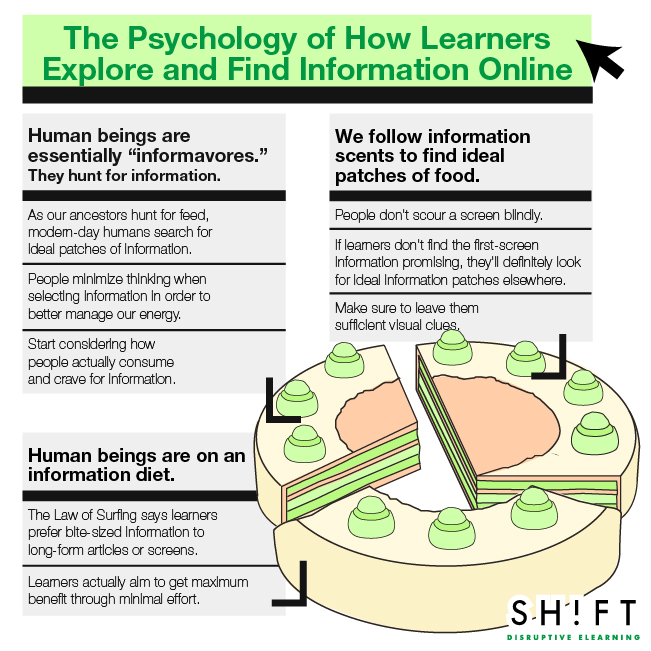Psychologists, eLearning professionals and other experts have always been interested in how we consume information online. Receiving and transmitting information are not new to us. But our entirely novel information environments are clearly shaping the way we search for and consume information. Today, "providing people with access to more information is not the problem. Rather, the problem is one of maximizing the allocation of human attention to information that will be useful.”
There are too many concepts and theories to mention but the most notable among them is the “Information Foraging Theory.” The term was first suggested by Pamela Sanstrom in 1994 and was later expanded by Pirolli and Stuart Card. The theory is based on the assumption that we humans use our built-in foraging mechanisms when searching for information. We inherited these mechanisms from our ancestors who forage or hunt for food. So it shouldn't surprise us that, today, we voraciously hunt for information instead of hunting for food.
Here are some relevant points of the theory. Feel free to carry out further research. It will certainly benefit your next eLearning project.

1. Human beings are essentially “informavores.” They hunt for information.
Just as our ancestors hunt for feed, we modern-day humans search for ideal patches of information. Our daily searches on the Internet and even offline propensity to share information or gather around stories are good examples. If these aren't enough proof, stay at your desk for a while and wait. You'll most likely going to surf the web or grab a book. It's okay, all us are naturally chasing content.
As information foragers, we're also naturally inclined to decide quickly on certain information. Should we read on or ignore an article? Is the video worth our time or not? We select which information to consume or minimize thinking in order to better manage our energy. The most successful among us are those skilled at collecting the right information at the right time.
What this all means to eLearning developers is simple. You have to start considering how people actually consume and crave for information. This is especially true when you're dealing with an artificially designed information environment such as the Web. You can shape it into a more effective medium by factoring in information foraging patterns. Think about how we information-hungry beings point at and click on items we find interesting. Or how we process what we see online with what we already know.
In short, learners are informavores. To give them the kind of information they want, you'll have to know them better.
2. We follow information scents to find ideal patches of food.
Researchers in Germany recently found that our heart, lung and blood cells are attracted to good food smells. But do you know that we also use visual clues—or information scent—to seek out ideal patches of information?
People don't just scour a screen blindly. When entering an eLearning course, for instance, learners look for clues on the main page or menu and then decide whether or not to stay. If they don't find the first-screen information promising, they'll definitely look for ideal information patches elsewhere. They'll keep on clicking and following links until they're satisfied.
Take a look at your navigation and search systems in your eLearning courses. Are users able to find what they're looking for using these tools? Make sure to leave them sufficient visual clues. The challenge for eLearning developers is to provide learners better access to the right kind of information—one that's complete, useful and reliable. Complete and integrated information is possible only when you have correlated data from different authentic sources. It's reliable when it has been proven true, and useful when it's applicable to learners' needs.
3. Human beings are on an information diet.
We're told that today's generation of learners and readers prefer bite-sized information to long-form articles or screens. That in lieu of reading, they just scan and surf. The Law of Surfing or the idea that we are all on an information diet aims to explain this.
It's not that learners are just lazy to exert effort. They actually aim to get maximum benefit through minimal effort. That's why they'll continue to surf and scan until they find good patches or ideal sources of information.
All of these points should help you, the eLearning professional, assess the work you do for learners. What should you really focus on? The Information Foraging Theory wants you to make it easier for learners to find meaningful information and focus on creating desirable information.
Final advice: “Observe how your users approach information, consider what it means, and design to allow them to achieve what they need.”
Further Reads:









